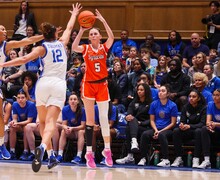When athletes look to transfer, schools have all the power
Illustration by Lucy Naland | Presentation Director
Amba Etta-Tawo put up historic numbers at Syracuse in 2016. If not for an NCAA rule, that could have been someone else.
The texts blew up Baylee Douglass’ phone.
Her teammates couldn’t find her name on the new roster posted that morning, and they were searching for answers.
“Hey, what’s going on,” they asked.
Douglass, now a pitcher at Syracuse, had requested a transfer from Southern Illinois University-Edwardsville. Douglass said Sandy Montgomery, her coach, had accepted her transfer request but asked her not tell anyone on the team. Then, Douglass said, the updated roster without her name was emailed to the team. After that, the texts came in.
She had listed seven schools as possible transfer destinations, including Syracuse, but then, Douglass said, the compliance office blocked Douglass from communicating with four of them. That also meant she could not transfer to those schools with a scholarship or immediate softball eligibility.
Often, athletes don’t expect schools to “block” their requests, Douglass said. She described her reaction as “disappointed,” because “most girls get full releases.”
“I was planning on this working out the whole time,” Douglass said. “If it didn’t, I’d have no idea what I was going to do.”
In 2016, the NCAA reported, 13.6 percent of male athletes and 9.2 percent of female athletes transferred to a different school. An NCAA rule requires players to request permission from his or her current school to transfer before they are released, like Pittsburgh men’s basketball player Cameron Johnson did this summer. Then, he made national headlines.
Pitt, Johnson’s school for three years, denied a full release to any Atlantic Coast Conference school, which prevented Johnson from attending North Carolina. But, according to multiple reports, once the public expressed outrage with the decision, the school relented.
What differentiates Johnson from the thousands of other transfers is that he switched from one high-profile program to another in one of the NCAA’s most-watched sports. He had national attention and support. Douglass didn’t. She represents the athlete’s story lesser known. There is no statistic for how many players each year have their request to communicate with a potential transfer destination blocked, which means it’s impossible to know how many others share Douglass’ story.

Anna Henderson | Contributing digital design editor
Syracuse Athletics, in compliance with the current NCAA rule, requires student-athletes to request permission to talk with other schools. Each request to talk to another school is handled by Mark Wheeler, SU associate athletic director of compliance.
The Daily Orange asked SU Athletics if it had ever denied a player’s request for permission to contact, as well as who would make the final decision on whether or not to allow a player to communicate with a school.
“Every request is handled individually and privately,” SU Athletics said in a statement.
Jay Bilas, an ESPN college basketball analyst and longtime player-power advocate, compared athletes situations to music students. If a musician wanted to transfer schools because he or she was unhappy with their seat in the orchestra, the university would have no say in where the student went.
“How (schools) could say with a straight face that players should not be allowed to transfer is absurd,” he said. “They should be embarrassed by that stance.”
Media coverage influencing public opinion, like it did for Johnson, is often an athlete’s only hope to clear “a blocked transfer,” Bilas said. But he also cautioned that fans flip their support between player and program based upon which decision helps the team they root for the most.
Bilas formerly played and coached basketball at Duke, so he took special interest in his alma mater’s involvement with its former quarterback Thomas Sirk.
In May, Duke denied Sirk a release because, the school said, he had too much knowledge of the program to go to another ACC school. Bilas argued Sirk could have quit football, gotten a paid job at North Carolina and taken his “state secrets” with him. Concerns about playing against a transfer’s new team in conference play is one of the most common explanations for stopping a player from communicating with schools.
“The athletes don’t have the formula for Kentucky Fried Chicken or Coca-Cola,” Bilas said. “It’s not that big of a deal.”
According to NCAA guidelines, neither a coach nor an athletic program is required to grant a player a release to any school. If the player chooses to attend a school from the blocked communication list anyway, he or she may not accept a scholarship for a year. This includes graduate transfers.
Currently, the NCAA said, it is attempting to change the rule that prohibits athletes from contacting other schools without permission from his or her current school. In a plan formulated earlier this year, the NCAA said it would attempt to inform athletes before beginning their first year because players “should be better educated about NCAA, conference and campus rules and potential implications related to transferring.”
In December 2015, Syracuse hired Dino Babers as its next head football coach. Left behind at Bowling Green was Babers’ star wide receiver, Gehrig Dieter, who had just had a career year with 1033 yards, 10 touchdowns and 94 receptions. He considered himself “a master” of Babers’ system, so when his coach left, he wanted to follow.
Babers’ departure caused significant turnover on BGSU’s squad and several recruits decommitted. When Dieter approached Bowling Green to request a release, he said, he thought athletic director Chris Kingston didn’t want to lose another player.
Dieter had approached compliance with three schools: Alabama, Wake Forest and, because of Babers, Syracuse. Dieter remembers Kingston telling him that he was going to block Dieter from Syracuse, and that he should exclude SU from his search. Dieter described himself as nonconfrontational and that he doesn’t like “dramatic situations,” so Dieter accepted Kingston’s decision and moved on, ending up at Alabama.

Andy Mendes | Digital design editor
Syracuse, instead, landed a new graduate transfer from Maryland. Amba Etta-Tawo went on to have one of the best wide receiver seasons in SU history. Dieter, who dreamt of playing in the NFL, caught 15 passes for 214 yards for the Tide. Dieter went undrafted in the 2017 NFL Draft and the Kansas City Chiefs later cut him. Dieter’s perception of his situation supported Bilas’ view on college sports.
“It’s about trying to maintain your assets,” Bilas said.
Willie Allen, a former Louisiana State offensive lineman, faced a similar situation when LSU blocked any transfer to fellow Southeastern Conference schools. Now, though, the Orange may benefit. Allen enrolled at Tyler Junior College, where he wouldn’t lose a year of eligibility. It also prevented LSU influencing his next school decision and, in August, Allen received an offer from Syracuse.
Schools’ decisions to prevent transfers remains largely about competition, Douglass said, because teams don’t want opponents to gain an advantage from players it once had.
None of the athletes interviewed by The Daily Orange regretted where he or she ended up, but none also understood fully why they were not allowed to go where they wanted. Dieter felt he should be rewarded for the four years he spent completing his sports management degree at Bowling Green.
“If you graduate,” Dieter said, “you should really be able to go wherever you want.”
The restrictions made the process difficult for Douglass. Looking back on the process, Douglass imagines herself being in the same situation as her coach with a player who wanted to transfer.
“After going through it myself,” Douglass said. “I don’t think I could stop them.”
Published on October 3, 2017 at 11:10 pm
Contact Michael: mmcclear@syr.edu | @MikeJMcCleary





